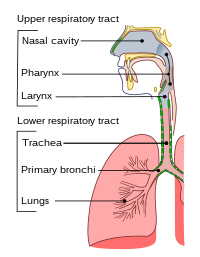
Photo from wikipedia
Objectives: To review the risk of airborne infections in schools and evaluate the effect of intervention measures reported in field studies. Background: Schools are part of a country’s critical infrastructure.… Click to show full abstract
Objectives: To review the risk of airborne infections in schools and evaluate the effect of intervention measures reported in field studies. Background: Schools are part of a country’s critical infrastructure. Good infection prevention measures are essential for reducing the risk of infection in schools as much as possible, since these are places where many individuals spend a great deal of time together every weekday in a small area where airborne pathogens can spread quickly. Appropriate ventilation can reduce the indoor concentration of airborne pathogens and reduce the risk of infection. Methods: A systematic search of the literature was conducted in the databases Embase, MEDLINE, and ScienceDirect using keywords such as school, classroom, ventilation, carbon dioxide (CO2) concentration, SARS-CoV-2, and airborne transmission. The primary endpoint of the studies selected was the risk of airborne infection or CO2 concentration as a surrogate parameter. Studies were grouped according to the study type. Results: We identified 30 studies that met the inclusion criteria, six of them intervention studies. When specific ventilation strategies were lacking in schools being investigated, CO2 concentrations were often above the recommended maximum values. Improving ventilation lowered the CO2 concentration, resulting in a lower risk of airborne infections. Conclusions: The ventilation in many schools is not adequate to guarantee good indoor air quality. Ventilation is an important measure for reducing the risk of airborne infections in schools. The most important effect is to reduce the time of residence of pathogens in the classrooms.
Journal Title: International Journal of Environmental Research and Public Health
Year Published: 2023
Link to full text (if available)
Share on Social Media: Sign Up to like & get
recommendations!